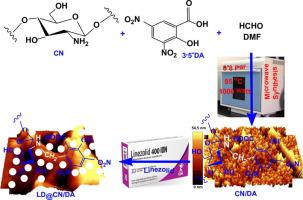Saudi Pharmaceutical Journal ( IF 3.0 ) Pub Date : 2020-06-18 , DOI: 10.1016/j.jsps.2020.06.005 Mahmoud H Teaima 1 , Mohamed K Elasaly 1 , Samia A Omar 2 , Mohamed A El-Nabarawi 1 , Kamel R Shoueir 3

|
To obtain a healthy human being with beneficial microflora against different pathogenic infections, classical antibiotics with nanosized biomaterials were used to inhibit the growth of bacterium by their potent synergistic effect. Hence, this study planned to load an oxazolidinone antibiotic named linezolid (LD) onto functionalized chitosan (CN) with 3, 5- dinitrosalyslic acid (DA) via microwave synthesis without harsh condition. The exploring synergistic effect of linezolid (LD) with CN/DA controllable nanostructure was compact efflux-mediated methicillin-resistant Staphylococcus aureus (MRSA) burden and other selected bactericide Gram-positive ((S. aureus), Gram-negative (E. coli), Fungi (C. albicans), Yeast (A. niger), and E. faecalis. The obtained results showed that LD was incorporated into both the internal and external surface of the aggregated CN/DA nanosystem with an average diameter of 150 nm ± 4 hints of the drug loading. Owing to the nature of functionalized CN, the release efficiency attains 98.4% within 100 min. The designed LD@CN/DA exhibited inhibition zone 54 mm, 59 mm, 69 mm, 54 mm, 57 mm, and 24 mm against the tested microbes respectively rather than individual LD. The major target of the current research is achieved by using LD@CN/DA as a nanoantibiotic system that has exceptional consistently active against multi-resistant pathogens, in between MRSA which resist LD. Also, cell viability was performed even after three days of direct cell culture on the surface of the designed nanoantibiotic. The mechanism of microbial inhibition was correlated and rationalized to different charges and the presence of oxygen species against microbial infections. Our findings provide a deep explanation about nanostructured antibiotics design with enhanced potentially pathogen-specific activity.
中文翻译:

功能化壳聚糖纳米抗生素系统的环保合成,可作为抗菌剂传递利奈唑胺。
为了获得具有对抗不同病原体感染的有益微生物群的健康人体,经典抗生素与纳米生物材料被用来通过其强大的协同作用来抑制细菌的生长。因此,本研究计划在不苛刻的条件下通过微波合成将一种名为利奈唑胺(LD)的恶唑烷酮类抗生素负载到具有3, 5-二亚硝基水杨酸(DA)的功能化壳聚糖(CN)上。探索具有 CN/DA 可控纳米结构的利奈唑胺 (LD) 与其他选定的杀菌剂对革兰氏阳性菌(S. aureus)、革兰氏阴性菌 ( E. coli ) 的紧密外排介导的耐甲氧西林金黄色葡萄球菌 (MRSA) 负荷的协同作用)、真菌 (C. albicans)、酵母 (A. niger)和E. faecalis获得的结果表明,LD 并入平均直径为 150 nm 的聚集 CN/DA 纳米系统的内表面和外表面。由于功能化 CN 的性质,设计的 LD@CN/DA 的释放效率在 100 分钟内达到 98.4%,抑制区域为 54 mm、59 mm、69 mm、54 mm、57 mm。和 24 mm 分别针对测试微生物,而不是单个 LD 目前研究的主要目标是通过使用 LD@CN/DA 作为纳米抗生素系统来实现,该系统对多重耐药病原体(介于 MRSA 之间)具有出色的持续活性。此外,甚至在设计的纳米抗生素表面直接细胞培养三天后也进行了细胞活力测试。微生物抑制机制与不同的电荷和抗微生物感染的氧的存在相关并合理化。 我们的研究结果为具有增强的潜在病原体特异性活性的纳米结构抗生素设计提供了深入的解释。











































 京公网安备 11010802027423号
京公网安备 11010802027423号